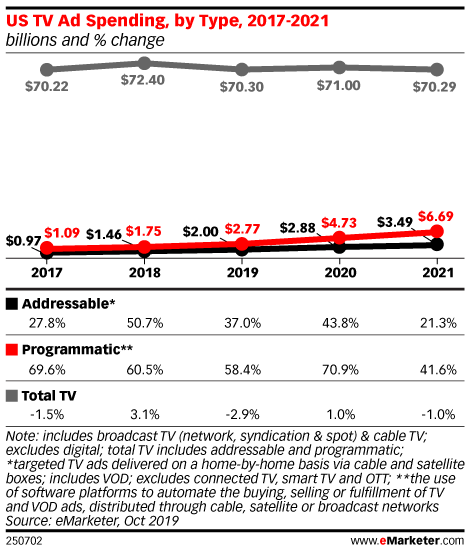There are those in the media industry who think anything that can be automated will be automated.
But, when it comes to TV, even connected TV, it’s not yet entirely clear that everything will be automated.
In this video interview with Beet.TV, Roku VP of product management for advertising Louqman Parampath describes how his company wants to get there.
Programmatic rising

EMarketer in November estimated programmatic TV ad spending will reach $6.69 billion in the US by 2021, more than doubling from $2.77 billion.
That makes it a still-small but fast-growing part of the overall TV ad spending pie – 9.5% overall.
Ad buyers are getting interested by the ability to target specific audiences or households, the ability to use other data in doing so and the ability.
Growth factors
Roku’s Parampath says the CTV sector has had to fix issues including:
Identifiers
“When we started advertising on Roku five, six years ago, a lot of ad serving was fairly based on cookies and did not support the cookieless ecosystem very well,” he says. “Connected TV, similar to the mobile app ecosystem, is a cookieless ecosystem. So we worked on setting up an advertising ID, a Roku-specific advertising ID that can be used for frequency capping, that can be used for better targeting, and that can be used for better analytics and measurement.”
Server-side setup
“The other areas where ad serving had to evolve to meet the needs of connected TV are around integration with server-side ad insertion (SSAI). A lot of premium video is all server-side ad-inserted. And so, oftentimes, ad servers have to integrate with SSAI vendors.”
Pod management
“Connected TV’s typically a multi-ads-in-a-pod kind of an environment. So managing the competitive ad exclusion in a pod and sharing frequency capping in a pod and so on are important changes that many ad servers have had to support.”
Coming to a head
And the considerations don’t stop there.
The technology that has unlocked programmatic in desktop display and mobile was header bidding – allowing publishers to entertain ad bids from multiple demand sources simultaneously, thereby reaping higher yield.
But header bidding is more challenging to make work in a CTV environment. Parampath says it is “nascent” there.
“There’s a lot of innovation to happen there,” he says. “It will go in the direction of digital where it is more mature.
“But you would expect a somewhat of a different adoption trajectory and a somewhat of a different set of features required to make header bidding and connected TV work.
“Connected TV header bidding will have to look at how it works in a server-side ad in certain environments, how it works with SDKs that have to be integrated into multiple publisher apps in some scenarios and how does it manage challenges around video latencies and so on.”
You are watching “Making CTV Happen: A New Ad Infrastructure Emerges,” a Beet.TV leadership video series presented by Publica. For more videos, please visit this page.




































